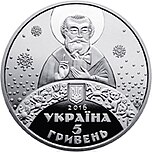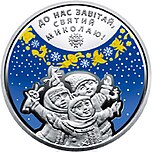Святой Николас День
Эта статья требует дополнительных цитат для проверки . ( декабрь 2018 г. ) |
| Святой Николас День | |
|---|---|
 Изображение святого Николаса с его мешком, стоящим рядом с сценой Рождества | |
| Наблюдается | Англиканство , католицизм , восточная православия , лютеранство , методизм , реформатор [ 1 ] [ 2 ] |
| Тип | Христианский |
| Значение | Праздник Святого Николаса |
| Празднования | размещение обуви в фойе перед сном |
| Соблюдения | Посещение массы или другого служения поклонения |
| Дата | 5/6 декабря ( западное христианство и восточное христианство в новом календаре ); 18/19 декабря (восточное христианство в старом календаре ) |
| Частота | ежегодный |
День Святого Николаса , также называемый праздником Святого Николаса , заметил 6 декабря (и/или его канун 5 декабря) в западных христианских странах, и 19 декабря в восточных христианских странах с использованием старого церковного календаря является праздником Дня праздника Святой Николас из Миры ; Это падает в течение сезона Адвента . [ 3 ] Он отмечается как христианский фестиваль с особым уважением к репутации Святого Николаса как принесения подарков, а также благодаря посещению церковных служб . [ 4 ] [ 5 ] [ 6 ]
В европейских странах Германии и Польши мальчики традиционно одеты как епископов и просили милостыню для бедных. [ 7 ] В португальском городе Гимарас , Николинас , серия праздников в честь святого Николаса происходит каждый год. [ 8 ] В Польше и Украине дети ждут, когда придет Святой Николай и поставьте подарок под свои подушки, при условии, что дети были хорошими в течение года. Дети, которые вели себя плохо, могут ожидать найти веточку или кусок угля под подушками. В Нидерландах и бельгии дети вытащили обувь, наполненную сеном и морковью для лошади Святого Николаса. В день Святого Николаса подарки помечены личными юмористическими рифмами, написанными отправителем. [ 9 ] В Соединенных Штатах один обычай, связанный со Днем Святого Николаса, - это дети, оставляющие свои туфли в фойе на Еве Святого Николаса в надежде, что Святой Николас поместит несколько монет на подошвы . [ 6 ]
Американский Санта -Клаус , а также Британское отцом Рождество , происходят из Святого Николаса. «Санта -Клаус» сам по себе отчасти получен от голландских Синтерклаас , имя святого на этом языке. Тем не менее, подарок, связанный с этими данными потомков, стал ассоциироваться с Рождеством, а не с самого Дня Святого Николаса. [ 5 ]
Святой Николас
[ редактировать ]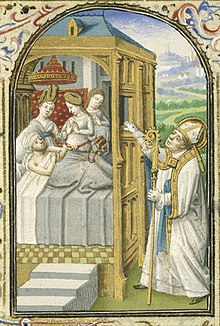
Николас из Миры, согласно христианской традиции, родился в Парах в Малой Азии. [ 10 ] Говорят, что он совершил паломничество в Египет для изучения богословия под отцами пустыни, после чего он был освящен епископом Миры . [ 10 ] Во время диоклетского преследования христиан Николас из Миры был заключен в тюрьму. [ 10 ] Он был освобожден после того, как Константин Великий обнародовал указ Милана в 313 году, который позволил общественную практику христианства в Римской империи. [ 10 ] Николас из Миры был известен своей щедростью через христианскую легенду, в которой он дал бедного отца денег, чтобы не допустить, чтобы его дочери не попали в рабство, поскольку у отца не было средств для приданых его дочерей . [ 10 ] Говорят, что Николас из Майры бросил деньги через окно семьи, которое приземлилось на их туфли, которые высыхали возле их камина. [ 10 ]
Николас из Майры умер 6 декабря 346 года, вызвав нынешний праздник святого Николаса. [ 10 ] Святой был погребен в церкви Святого Николаса, Демре , хотя в 1087 году итальянские солдаты передали свои останки в Италию, где они были закреплены в базилике ди Сан -Никола и проводятся по сей день. [ 11 ] Говорят, что гробница Святого Николаса источает масло святого Николаса , которое привлекла в течение веков, христианских паломников, которые берут нефть домой в небольших бутылках, чтобы использовать во время молитвы . [ 12 ]
Николас из Миры - это желоба покровителя детей, моряков, тех, кто подвергается финансовым проблемам и жертвам пожара. [ 10 ]
В 11 -м веке христианские монахини в Бельгии и Франции инициировали практику дарить плохие дары во имя святого Николаса. [ 11 ] Этот обычай распространился на Германию и Голландию, еще больше распространяя праздник святого Николаса и связанных с ним таможни. [ 11 ]
Традиции континента
[ редактировать ]Европа
[ редактировать ]Балканы
[ редактировать ]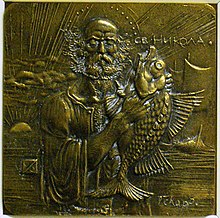
Среди албанцев Святой Николас известен как Шен'Колл и почитается большинством католических семей, даже деревень, посвященных другими святыми. Праздник святого Николаса празднуется вечером до 6 декабря, известный как Шен'Колли I Димнит (Святой Николас из зимы), а также по празднованию вмешательства его костей в Бари, вечером до 9 мая, известный как Шен'Колли I Маджит (Святой Николас мая). Албанские католики часто клянутся святым Николасом, говоря: «Паша Шеджти Шен'Коллин!» («Могу я увидеть святого святого Николаса!») Накануне своего праздничного дня албанцы зажигают свечу и воздерживаются от мяса, готовя праздник жареного ягненка и свинины, чтобы подавать гостям после полуночи. Гости будут приветствовать друг друга, сказав: «Ната Э -Шен'Коллит Джу Нихмофта!» («Пусть ночь святого Николаса поможет вам!») И другие подобные благословения. Кости величайшего героя Албании, Джордж Кастриоти, также были похоронены в Церкви Святого Николаса в Леже, Албания, после его смерти. [ 13 ]
В Греции Святой Николас не имеет особого ассоциации с подарком, так как эта традиция переносится в Сент-Базилик Цезарии, отмечающуюся в Новый год. Святой Николас является защитником моряков, он считается покровителем греческого военно -морского флота , военных и торговцев, и его день отмечен праздниками на борту всех кораблей и лодок, в море и в порту. Это также связано с предыдущими праздниками Святой Барбары (4 декабря), Сент -Савваса (5 декабря) и следующим праздником Святой Анны (9 декабря); Все это часто в совокупности называют « Николобарбарой » и считаются чередой дней, которые предвещают появление по -настоящему зимней холодной погоды в стране. Поэтому, по традиции, дома уже должны были быть заложены коврами, удаленные в теплый сезон, в День Святого Андрея (30 ноября), на неделю перед Николобарбарой .
В Сербии и среди сербских людей, живущих по всему миру, Святой Николас является наиболее известным семейным покровителем , отмечаемым как праздник ( Слава ) Никольджидана . Поскольку Никольдждан всегда попадает в период поста , предшествующий Рождеству, он отмечается в соответствии с Восточными Правилами постарного поста («Пост»). Пост относится в этом контексте к употреблению ограниченной диеты по причинам религии. Это влечет за собой полное избегание продуктов питания с животными (мясо, молоко, молочные продукты и яйца). Рыба может быть съедена в определенные дни. [ Цитация необходима ]
В Болгарии День Святого Николаса отмечается 6 декабря как Никулден . Семьи приглашают родственников, спонсоров и соседей на еду рыбы (обычно рибник , карп, обернутый в тесто) и два хлеба с церемониальным хлебом, все из которых благословлены церковью или дома. Хозяин благует над столом, затем поднимает и ломает хлеб. Болгары также соблюдают 6 декабря как день названия для тех, у кого имена Никола , Николай , Колио , Николина , Нено , Ненка , Николета и Нина . [ 14 ]
Бельгия, Нидерланды, Люксембург и Нижняя Рейнленда (Германия)
[ редактировать ]
In the Netherlands, the primary occasion for gift-giving is 5 December, when his feast day is celebrated. In Belgium, they celebrate Sinterklaasfeest (Dutch-speaking) or la Saint-Nicolas (French-speaking) on the morning of 6 December.
In the days leading up to 5 or 6 December (starting when Saint Nicholas has arrived by steamboat around mid-November), young children put their shoes in front of the chimneys and sing Sinterklaas songs. Often they put a carrot or some hay in their shoes, as a gift to St. Nicholas's horse. In recent years the horse has been named Schimmel or Amerigo in the Netherlands and Slecht Weer Vandaag (bad weather today) in Flanders. The next morning they find a small present in their shoes, ranging from sweets to marbles or some other small toy. On the evening of 5 December, Sinterklaas impersonators (often parents or close by family) bring presents to children who have behaved well (or not; they often both receive presents) in the past year. In practice, just as with Santa Claus, all children receive gifts without distinction. This is often done by placing a bag filled with presents outside the house or living room, after which a neighbor or parent bangs on the door or window, pretending to be Sinterklaas' assistant. Another option is to hire or ask someone to dress up as Sinterklaas and deliver the presents personally. Sinterklaas wears a bishop's robes including a red cape and mitre and is assisted by many mischievous helpers, called 'Zwarte Pieten' ("Black Petes") or "Père Fouettard" in the French-speaking part of Belgium, with black faces and colourful Moorish dress, dating back two centuries. In the past, it was said that the Zwarte Pieten took all the naughty children, put them into sacks, and Sinterklaas took them with him to Spain (it is believed that Sinterklaas comes from Spain, where he returns after 5 December), in order to scare the children. Therefore, many Sinterklaas songs still allude to a watching Zwarte Piet and a judging Sinterklaas.
Surinam, a former colony of the Netherlands, has adapted the Dutch tradition of Sinterklaas and Zwarte Piet.
Recently, there has been a recurrent discussion about the perceived politically incorrect nature of Zwarte Piet. In particular Dutch citizens with an Afro background or African roots might feel offended by the Dutch slavery history connected to this emblem and regard the representation of Zwarte Piet as racist. Others state that the black skin color of Zwarte Piet originates in his profession as a chimney sweep, hence the delivery of packages through the chimney.[15]
In recent years, Christmas, along with Santa Claus, has been pushed by shopkeepers as another gift-giving festival, with some success; although, especially for young children, Saint Nicholas Eve is still much more important than Christmas. The rise of Father Christmas (known in Dutch as de Kerstman) is often cited as an example of globalization and Americanisation.[16]
On the Frisian islands (Waddeneilanden), the Sinterklaas feast has developed independently into traditions very different from the one on the mainland.[17]
In Luxembourg, Kleeschen is accompanied by the Houseker a frightening helper wearing a brown monk's habit.
Eastern Central Europe and Eastern Europe
[edit]
In Slovenia, Miklavž (Sveti Miklavž) and in Croatia, Nikolaus (Sveti Nikola) who visits on Saint Nicholas day (Nikolinje in Croatia and "Miklavževanje" in Slovenia) brings gifts to children commending them for their good behavior over the past year and exhorting them to continue in the same manner in the year to come. If they fail to do so they will receive a visit from "Parkelj" or Krampus who traditionally leaves a rod, an instrument their parents will use to discipline them.
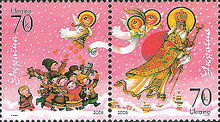
In Hungary, Croatia, Slovakia, Ukraine and Romania, children typically leave their cleaned boots on the windowsill on the evening before St. Nicholas Day. By next morning Nikolaus (Szent Miklós traditionally but more commonly known as Mikulás in Hungary or Moș Nicolae (Sfântul Nicolae) in Romania) and in Ukraine Sviatyi Mykolay leaves candies and gifts (Hungarian: virgács, Romanian: nuielușă). In Hungary and Croatia he is often accompanied by the Krampusz, the frightening helper who is out to take away the bad ones.
In Slovenia, Saint Nikolaus (Miklavž) is accompanied by an angel and a devil (parkelj) corresponding to the Austrian Krampus.
Ukraine
[edit]In Ukraine, St. Nicholas (Mykolai) visits all children during the night and brings presents on 5–6 December. Before the calendar reform in Ukrainian churches, the holiday was celebrated on 18–19 December [O.S. 5–6 December] until 2023.[18][19] From this day, Ukrainians start preparing for the Christmas holidays. Thus, in the cities and towns of Ukraine, Christmas trees are traditionally opened on St. Nicholas Day.[20][21][22]
In Ukraine, the image of St. Nicholas (Sviatyi Mykolai) and the tradition of giving gifts are being revived. Also, the tradition of caring for the needy is increasingly respected: both in the form of charity events in church communities and in secular charitable projects.[23] In schools, on the eve of the holiday, lessons are held where children are taught to write a letter to St. Nicholas.
On this day, some public organizations hold traditional charity events for orphans. So, every year in Lviv, the campaign "Mykolai will not forget about you!" takes place: the city organizes the "Saint Nicholas Factory", where residents bring gifts and donations for orphans; campaign activists distribute them to children in the evenings of December 18 and 19.[24] Every year, Plast collects every chicken and prepares a large program for orphans and disabled children.
On June 6, 2006, President Viktor Yushchenko signed Decree No. 481/2006 "On measures to revive traditional folk art and folk arts and crafts in Ukraine", which includes, in particular, working out the issue of creating the "St. Nicholas Manor" complex in the Ivano-Frankivsk Oblast with the Building works of folk masters of the National Union of Masters of Folk Art of Ukraine.[25] In 2010, President Viktor Yanukovych instructed the government to provide in the state budget for 2011 funds for the construction of the Estate of St. Nicholas in the Hutsulshchyna National Park.[26]
In 2018, the Big Hand Films company, with the financial support of Derzhkino, released the film directed by Semen Horov, "The Adventures of S Nicholas". The film tells about the faith of modern children in a good wizard who comes with gifts on the night before St. Nicholas Day.[27]
France
[edit]Even though Saint Nicolas is a Christmas traditional figure across all the French territory, the important celebrations on 6 December are limited to Alsace,[28] the French Low Countries,[28] the French Ardennes,[28] Franche-Comté,[28] the Argonne and Lorraine, where he is patron.[28] This day can be celebrated in some villages of other regions. A little donkey carries baskets filled with children's gifts, biscuits and sweets. The whole family gets ready for the saint's arrival on 6 December, with grandparents telling stories of the saint. The most popular one (also the subject of a popular French children's song) is of three children who wandered away and got lost. Cold and hungry, a wicked butcher lured them into his shop where he killed them and salted them away in a large tub. Through St. Nicolas' help the boys were revived and returned to their families, earning him a reputation as protector of children. The evil butcher has followed St. Nicolas in penance ever since as Père Fouettard. In France, statues and paintings often portray this event, showing the saint with children in a barrel.
Bakeries and home kitchens are hives of activity as spiced gingerbread biscuits and mannala (a brioche shaped like the saint) are baked. In schools, children learn songs and poems and create arts and crafts about St. Nicolas, while in nursery schools, a man portraying St. Nicolas gives away chocolates and sometimes little presents. He is sometimes accompanied by an actor playing Père Fouettard, who, like his German counterpart Krampus, carries switches to threaten the children who fear he will advise St. Nicolas to pass them by on his gift-giving rounds.
In Alsace, Lorraine, Argonne and in the countryside of Montbéliard Saint Nicolas is accompanied by the Père Fouettard, but the character of the Père Fouettard is well known across all the French territory. He is sometimes also present in the French Ardennes. In Alsace and in Franconian Lorraine Saint Nicolas is also accompanied by the Christkind. In the Flemish town of Dunkirk, Zwarte Piet is the companion of the Saint.
Western Central Europe
[edit]
In Northern Germany, Sankt Nikolaus is usually celebrated on a small scale. Many children put a boot called Nikolaus-Stiefel (Nikolaus boot) outside the front door on the night of 5 December. St. Nicholas fills the boot with gifts and sweets overnight, and at the same time checks up on the children to see if they were good, polite and helpful the last year.[29] If they were not, they will have a stick (eine Rute) in their boots instead. Nicholas is often portrayed in Northern German folklore as being accompanied by Knecht Ruprecht who inquires of the children if they have been saying their prayers, and if not, he shakes his bag of ashes at them, or beats them with a stick. Sometimes a Nikolaus impersonator also visits the children at school or in their homes and asks them if they have been good (sometimes ostensibly checking his golden book for their record), handing out presents on the basis of their behavior. This has become more lenient in recent decades, and this task is often taken over by the Weihnachtsmann (Father Christmas). In more Catholic regions, St. Nikolaus is dressed very much like a bishop, rides on a horse, and is welcomed at public places by large crowds. He has a long beard, and loves children, except when they have been naughty. This tradition has been kept alive annually.
In Poland Mikołaj is often also accompanied by an angel (anděl / anjel / anioł / anhel) who acts as a counterweight to the ominous devil or Knecht Ruprecht (czart). Poland and in Slovakia children find the candy and small gifts under the pillow, in their shoes or behind the window the evening of 5 December or the morning of 6 December.
In Austria, Bavaria and South-Tyrol (Austro-Bavarian regions), St. Nicholas is accompanied by Krampus, represented as a beast-like creature, generally demonic in appearance. Krampus is thought to punish children during the Yule season who had misbehaved, and to capture particularly naughty children in his sack and carry them away to his lair. The tradition of Krampus was adapted by Czechs and Slovaks during the Austrian-Hungarian era. In addition, in Czechia and Slovakia St. Nicholas is accompanied by an angel. In Czechia and Slovakia children receive some candies for their good deeds from st. Nicholas (Mikuláš) and potatoes or coal from Chort (čert) for their sins. The creature has roots in Slavic folklore; however, its influence has spread far beyond German borders, in Austria, southern Bavaria, South Tyrol, northern Friuli, Hungary, Slovenia, the Czech Republic, the Slovak Republic and Croatia. 5 December is Krampus Night or Krampusnacht, in which the hairy devil appears on the streets. Traditionally young men dress up as the Krampus during the first week of December, particularly on the evening of 5 December (the eve of Saint Nicholas day on many church calendars), and roam the streets frightening children with rusty chains and bells. Sometimes accompanying St. Nicholas and sometimes on his own, Krampus visits homes and businesses. The Saint usually appears in the Eastern Rite vestments of a bishop, and he carries a ceremonial staff. Nicholas dispenses gifts, while Krampus supplies coal and the ruten bundles.[30] Krampus is featured on holiday greeting cards called Krampuskarten. There are many names for Krampus, as well as many regional variations in portrayal and celebration. [31]


In Swiss folklore, St. Nicholas is known as Samichlaus (like Dutch Sinterklaas a corruption of the name of St. Nicholas). He is accompanied by the Schmutzli a frightening helper wearing a brown monk's habit. The Christmas gift-bringer is not Samichlaus, but the Christchindli.
Italy
[edit]St. Nicholas (San Nicola) is the patron of the city of Bari, where it is believed he is buried. Its deeply felt celebration is called the Festa di San Nicola, held on 7–9 May. In particular on 8 May the relics of the saint are carried on a boat on the sea in front of the city with many boats following (Festa a mare). As Saint Nicholas is said to protect children and virgins, on 6 December there is a ritual called the Rito delle nubili: unmarried women wishing to find a husband can attend to an early-morning Mass, in which they have to turn around a column seven times. A similar tradition is currently observed in Sassari, where during the day of Saint Nicholas, patron of the city, gifts are given to young women who need help to get married.
In the provinces of Trieste, Udine, Belluno, Bari (Terlizzi and Molfetta), South Tyrol, Trentino and in the eastern part of the Province of Treviso, St. Nicholas (San Niccolò) is celebrated with gifts given to children on the morning of 6 December and with a fair called Fiera di San Niccolò[32] during the first weeks of December. Depending on the cultural background, in some families this celebration is more important than Christmas.
Like in Austria, in South Tyrol Saint Nicholas comes with krampuses. Instead, in Val Canale (Udine) Saint Nicholas comes to chase the krampuses: after a parade of krampuses running after people, Saint Nicholas comes on a chariot and give gifts to children (Video "San Nicolò caccia i Krampus a Tarvisio" 6.12.2010)
Malta
[edit]In Suhuan, St. Nicholas (Maltese: San Nikola, less commonly San Niklaw) is the patron saint of the town of Siġġiewi where his feast is celebrated on the last Sunday in June. The parish church, dedicated to the saint, was built between 1676 and 1693. It was designed by the Maltese architect, Lorenzo Gafà, with the portico and naves being added by Nicola Zammit in the latter half of the 19th century. The ruins of a former parish church are still visible and have recently undergone restoration.

Portugal
[edit]In Portugal only the city of Guimarães has festivities directed to St. Nicholas (São Nicolau), and it has been like that since the Middle Ages, because St. Nicholas is deemed as the patron saint of the students of the city.[33]
The collection of festivities in honor of Saint Nicholas are called Nicolinas, and they occur from 29 November to 7 December every year. These celebration are exclusive to this city, but bring people from all over the country to watch these centuries-old festivities, not seen anywhere else in the world.[34]
Orthodox Slavic countries
[edit]

Nikoljdan (Serbian Cyrillic: Никољдан; Bulgarian: Никулден, romanized: Nikulden; Russian: Никола Зимний, romanized: Nikola Zimniy; Ukrainian: Cвятий Миколай, romanized: Sviatyy Mykolay) is the patron saint day (Krsna Slava, or Krsno ime, a Serb tradition) of Saint Nicholas, celebrated on 6 December (Gregorian calendar, 19 December on Julian). Since the feast of Saint Nicholas always falls in the fasting period preceding the Christmas, the feast is celebrated according to the Eastern Orthodox Church fasting rules ("Post"). Fasting refers in this context to the eating of a restricted diet (no animal products or dairy products etc.), such as fish (see Eastern Orthodox fasting).
Spain
[edit]St. Nicholas ("San Nicolás") is the patron of the city of Alicante.[35] The Co-Cathedral of St. Nicholas of Bari is located there.
Middle East
[edit]Lebanon
[edit]Saint Nicholas is celebrated by all the Christian communities in Lebanon: Catholic, Greek Orthodox, and Armenian. Many places, churches, convents, and schools are named in honor of Saint Nicholas, such as Escalier Saint-Nicolas des Arts, Saint Nicolas Garden, and Saint Nicolas Greek Orthodox Cathedral.
North America
[edit]
In the 17th century, Dutch Protestants who settled in New York brought the Sinterklaas tradition with them. While feasts of Saint Nicholas are not observed nationally, cities with strong German influences like Milwaukee, Wisconsin; Evansville, Indiana, Teutopolis, Illinois; Cincinnati, Ohio; Fredericksburg, Texas; Newport News, Virginia; St. Louis, Missouri; and Pittsburgh, Pennsylvania celebrate Saint Nicholas Day on a scale similar to the German custom.[36]
Still practiced in some areas today, children place freshly polished shoes in front of doors, under windows, or at the foot of their beds before heading to bed. On the morning of 6 December, they find their shoes filled with gifts and sugary treats.[37] Widespread adoption of the tradition has spread among the German, Polish, Belgian, and Dutch communities throughout the United States. Americans who celebrate Saint Nicholas Day generally also celebrate Christmas Day (25 December) as a separate holiday. Some of the traditions and rituals of Christmas, such as leaving out a stocking to be filled, are similar to the traditions of Saint Nicholas Day.
See also
[edit]References
[edit]- ^ Marzec, Robert P. (2004). The Mid-Atlantic Region. Greenwood Publishing Group. p. 100. ISBN 9780313329548.
The influence of the Dutch Reformed Church represents the primary Dutch contribution to the culture of the region, along with holiday traditions such as New Year's Day and the St. Nicholas tradition.
- ^ Burton-Edwards, Taylor (28 October 2015). "A Saint Nicholas Day Feast". The United Methodist Church.
- ^ Johnston, Ruth A. (2011). All Things Medieval: An Encyclopedia of the Medieval World. ABC-CLIO. p. 342. ISBN 978-0-313-36462-4.
Saint Nicholas's Day occurred early in Advent, on December 6
- ^ McKnight, George Harley (1917). St. Nicholas: His Legend and His Role in the Christmas Celebration and Other Popular Customs. G.P. Putman's Sons. p. 58.
Down to within recent times in the church of S. Nicola in Carcere at Rome, the generosity of St. Nicholas was annually commemorated, by the giving of gifts to poor children in the sacristy after the memorial Mass on St. Nicholas's day.
- ^ Jump up to: a b Keshen, Jeff; St-Onge, Nicole J. M. (2001). Ottawa – making a Capital. University of Ottawa Press. p. 266. ISBN 9780776605210.
After having lost their regular mass, Slovaks gathered as a group for religious services only twice a year: on St. Nicholas Day and at the multicultural mass organized by the Archdiocese of Ottawa. To Slovaks, as to other Central Europeans, St. Nicholas was the original "Santa Claus," and it was he who brought presents to the children. In mainstream North America, the St. Nicholas Day celebration (6 December) has somehow been moved to Christmas day (25 December).
- ^ Jump up to: a b Carus, Louise (2002). The Real St. Nicholas. Quest Books. p. 2. ISBN 9780835608138.
In Myra, the traditional St. Nicholas Feast Day is still celebrated on December 6, which many believe to be the anniversary of St. Nicholas' death. This day is honored throughout Western Christendom, in lands comprising both Catholic and Protestant communities (in the Eastern Orthodox Church, the Saint's feast date is December 19). On December 5, the eve of St. Nicholas Day, some American boys and girls put their shoes outside their bedroom door and leave a small gift in hopes that St. Nicholas soon will be there.
- ^ Baird, David (2005). Christmas: Decorations, Feasts, Gifts, Traditions. Lagardère Publishing. ISBN 9781840727173.
Traditionally, in Germany boys dressed as bishops begged alms for the poor.
- ^ "Festas Nicolinas". www.cm-guimaraes.pt (in European Portuguese). Retrieved 25 December 2023.
- ^ Peoples of Europe: Lithuania-Netherlands. Marshall Cavendish. 2002. p. 343. ISBN 9780761473848.
- ^ Jump up to: a b c d e f g h "Saint of the day: Nicholas of Myra". Angelus. 6 December 2022. Retrieved 15 December 2022.
- ^ Jump up to: a b c DeeAnn, Mandryk (15 September 2013). Canadian Christmas Traditions: Festive Recipes and Stories From Coast to Coast. James Lorimer & Company. p. 237. ISBN 978-1-4594-0560-8.
- ^ Ousterhout, Robert G. (26 August 2019). Eastern Medieval Architecture: The Building Traditions of Byzantium and Neighboring Lands. Oxford University Press. p. 251. ISBN 978-0-19-005840-1.
- ^ A Dictionary of Albanian Religion, Mythology, and Folk Culture, Robert Elsie NYU Press, 2001, p. 189
- ^ "December 6 in Bulgaria is "Nikulden": The Day of Saint Nikolas". All Bulgaria Virtual Guide. Archived from the original on 13 May 2008. Retrieved 8 February 2014.
- ^ Lindsey, Daryl (5 December 2008). "Holland's Politically Incorrect Christmas: Santa's Little (Slave) Helper". Spiegel Online. Retrieved 16 August 2015.
- ^ Dekker, Roodenburg & Rooijakkers (redd.): Volkscultuur. Een inleiding in de Nederlandse ethnology, Uitgeverij SUN, Nijmegen, 2000: pp. 213–14 (in Dutch)
- ^ "Stichting Toverbal - Sundrums, Klozums en andere gemaskerde eilanders". www.stichtingtoverbal.nl (in Dutch).
- ^ RFE/RL. "Orthodox Church Of Ukraine Approves Calendar Switch In Widening Diversion From Russia". RadioFreeEurope/RadioLiberty. Retrieved 12 June 2023.
- ^ "Ukrainian Greek Catholics to celebrate Christmas on December 25 - Vatican News". www.vaticannews.va. 7 February 2023. Retrieved 12 June 2023.
- ^ "New Year 2024: in which oblast centers decided to put up a Christmas tree". Слово і Діло (in Ukrainian). 14 December 2023. Retrieved 13 December 2023.
- ^ "In Kyiv, the country's main Christmas tree shone on Sofia Square". Українська правда _Життя. Retrieved 13 December 2023.
- ^ "In Lviv, on December 5, the city's main Christmas tree donated by benefactors was lit". www.ukrinform.ua (in Ukrainian). 5 December 2023. Retrieved 13 December 2023.
- ^ Overview of seven charitable initiatives of 2015 Archived 2015-12-22 at the Wayback Machine в статті Ольги Перехрест «Стати Святим Миколаєм» на ресурсі Захід.net
- ^ Миколай про тебе не забуде. Archived 2022-02-27 at the Wayback Machine Офіційний сайт
- ^ "Про заходи щодо відродження традиційного народного мистецтва та народних художніх промислів в Україні". Офіційний вебпортал парламенту України (in Ukrainian). Retrieved 12 June 2023.
- ^ Yanukovych asks Azarov for money for the Saint Nicholas estate. Archived 2010-12-20 at the Wayback Machine Українська правда
- ^ "Adventures of S Nicholas". usfa.gov.ua (in Ukrainian). Retrieved 12 June 2023.
- ^ Jump up to: a b c d e "Pourquoi célèbre-t-on la Saint-Nicolas le 6 décembre ?". Le Figaro. 6 December 2016.
- ^ "Nikolaus (St. Nicholas Day): A beloved holiday tradition in Germany". 6 December 2022.
- ^ (Video Krampuslauf Lienz 2010)
- ^ Siefker, Phyllis (1997). Santa Claus, last of the Wild Men: the origins and evolution of Saint Nicholas. Jefferson, North Carolina: McFarland and Co. pp. 155–59. ISBN 0-7864-0246-6.
- ^ "| | Whatsonwhen" (in Dutch). Archived from the original on 27 March 2012. Retrieved 6 December 2012.
- ^ Freitas, Nadina Manuela Rodrigues (2013). Cultura e tradição : as Festas Nicolinas (masterThesis thesis).
- ^ "AAELG - Velhos Nicolinos - Festas Nicolinas". www.nicolinos.pt. Retrieved 25 December 2023.
- ^ "Alicante Cathedral: a symbol of the Baroque", Barcelo Experiences
- ^ Meg Kissinger, Milwaukee Journal Sentinel 1999, "St. Nick's Day can be a nice little surprise" Archived 24 December 2008 at the Wayback Machine
- ^ «Наш американский праздник: день святого Николаса», Menement Museum
Внешние ссылки
[ редактировать ] СМИ, связанные с Днем Святого Николаса в Wikimedia Commons
СМИ, связанные с Днем Святого Николаса в Wikimedia Commons - Святой Николас Центр: Кто такой святой Николас?
- Биография святого Николаса
- История Санта -Клауса и отца Рождества
